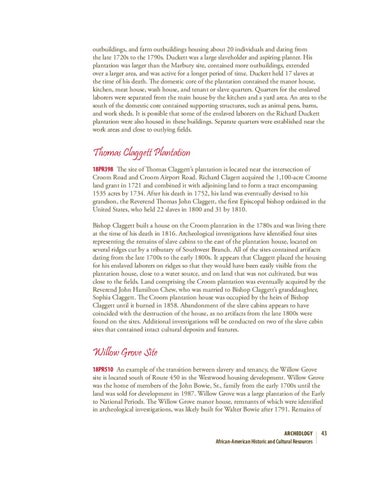outbuildings, and farm outbuildings housing about 20 individuals and dating from the late 1720s to the 1790s. Duckett was a large slaveholder and aspiring planter. His plantation was larger than the Marbury site, contained more outbuildings, extended over a larger area, and was active for a longer period of time. Duckett held 17 slaves at the time of his death. The domestic core of the plantation contained the manor house, kitchen, meat house, wash house, and tenant or slave quarters. Quarters for the enslaved laborers were separated from the main house by the kitchen and a yard area. An area to the south of the domestic core contained supporting structures, such as animal pens, barns, and work sheds. It is possible that some of the enslaved laborers on the Richard Duckett plantation were also housed in these buildings. Separate quarters were established near the work areas and close to outlying fields.
Thomas Claggett Plantation 18PR398 The site of Thomas Claggett’s plantation is located near the intersection of Croom Road and Croom Airport Road. Richard Clagett acquired the 1,100-acre Croome land grant in 1721 and combined it with adjoining land to form a tract encompassing 1535 acres by 1734. After his death in 1752, his land was eventually devised to his grandson, the Reverend Thomas John Claggett, the first Episcopal bishop ordained in the United States, who held 22 slaves in 1800 and 31 by 1810. Bishop Claggett built a house on the Croom plantation in the 1780s and was living there at the time of his death in 1816. Archeological investigations have identified four sites representing the remains of slave cabins to the east of the plantation house, located on several ridges cut by a tributary of Southwest Branch. All of the sites contained artifacts dating from the late 1700s to the early 1800s. It appears that Claggett placed the housing for his enslaved laborers on ridges so that they would have been easily visible from the plantation house, close to a water source, and on land that was not cultivated, but was close to the fields. Land comprising the Croom plantation was eventually acquired by the Reverend John Hamilton Chew, who was married to Bishop Claggett’s granddaughter, Sophia Claggett. The Croom plantation house was occupied by the heirs of Bishop Claggett until it burned in 1858. Abandonment of the slave cabins appears to have coincided with the destruction of the house, as no artifacts from the late 1800s were found on the sites. Additional investigations will be conducted on two of the slave cabin sites that contained intact cultural deposits and features.
Willow Grove Site 18PR510 An example of the transition between slavery and tenancy, the Willow Grove site is located south of Route 450 in the Westwood housing development. Willow Grove was the home of members of the John Bowie, Sr., family from the early 1700s until the land was sold for development in 1987. Willow Grove was a large plantation of the Early to National Periods. The Willow Grove manor house, remnants of which were identified in archeological investigations, was likely built for Walter Bowie after 1791. Remains of
ARCHEOLOGY African-American Historic and Cultural Resources
43
